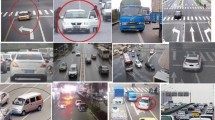Abstract
A convergence between a natural user interface (NUI) and advanced driver assistance system is considered as a next generation technology. This kind of interfacing system technology becomes more popular in driver assistance system of automobile. Especially, pedestrian detection is an important cue for intelligent vehicles and interactive driver assistance system. In this paper, we propose a pedestrian detection feature and technique by combining histogram of the oriented gradient (HOG) and discrete wavelet transform (DWT). In the method, the magnitude of motion is used to set region of interest (ROI) for improving detection speed. Then, we employ multi-feature for a pedestrian detection based on the HOG and DWT. In last stage, to classify whether a candidate window contains a pedestrian or not, the designed multi-feature is learned by using the training data with the support vector machine (SVM) mechanism. Experimental results show that the proposed algorithm increases the speed-up factor of 27.21 % by comparing to the existing method using the original HOG feature.














Similar content being viewed by others
References
Cellario M (2001) Human-centered intelligent vehicles: toward multimodal interface integration. IEEE Intell Syst 16(4):78–81
Cootes T, Taylor CJ (2004) Statistical models of appearance for computer vision. Imaging Science and Biomedical Engineering
Dalal N, Triggs B (2005) Histograms of oriented gradients for human detection. In: IEEE computer society conference on computer vision and pattern recognition, vol 1, pp 886–893
Dalal N, Triggs B, Schmid C (2006) Human detection using oriented histograms of flow and appearance. In: 9th Asian conference on computer vision, pp 428–441
David GL (2004) Distinctive image features from scale-invariant keypoints. Int J Comput Vis 60(2):91–110
Dollor P, Wojek C, Schiele B, Perona P (2009) Pedestrian detection: a benchmark. In: IEEE conference on computer vision and pattern recognition, vol 31, pp 304–311
Dollor P, Wojek C, Schiele B, Perona P (2012) Pedestrian detection: an evaluation of the state of the art. IEEE Trans Pattern Anal Mach Intell 34(4):743–761
Enzweiler N, Gavrila DM (2009) Monocular pedestrian detection: survey and experiments. IEEE Trans Pattern Anal Mach Intell 31(12):2179–1295
Gandhi T, Trivedi MM (2007) Pedestrian protection systems: issues, survey, and challenges. IEEE Trans Intell Transp Syst 8(3):413–430
Geronimo D, Lopez AD, Graf T (2010) survey of pedestrian detection for advanced driver assistance systems. IEEE Trans Pattern Anal Mach Intell 32(7):1237–1258
Goswami K, Hong G-S, Kim B-G (2013) A novel mesh-based moving object detection technique in video sequence. J Converg 4(3):20–24
Guoqing X, Xiaocui W, Zhengbin W (2011) Real-time pedestrian detection based on edge factor and Histogram of Oriented Gradient. In: IEEE international conference on information and automation, pp 384–389
Hou C, Ai H, Lao S (2007) Multiview pedestrian detection based on vector boosting. In: 8th Asian conference on computer vision, pp 18–22
INRIA person data. http://pascal.inrialpes.fr/data/human
Mallat SG (1989) A theory for multiresolution signal decomposition: the wavelet representation. IEEE Trans Pattern Anal Mach Intell 11(7):674–693
Mikolajczyk K, Schmid C, Zisserman A (2004) Human detection based on a probabilistic assembly of robust part detectors. In: 8th European conference on computer vision, vol 3021, pp 69–82
Nagi GM, Rahmat R, Khalid F, Taufik M (2013) Region-Based facial expression recognition in still images. J Inf Process Syst 9(1):173–188
Panganiban A, Linsangan N, Caluyo F (2011) Wavelet-based feature extraction algorithm for an iris recognition system. J Inf Process Syst 7(3):425–434
Papageorgiou C, Poggio T (2000) A trainable system for object detection. Int J Comput Vis 38(1):15–33
Patil PB, Kotare MB (2013) Interactive semantic image retrieval. J Inf Process Sys 9(3):349–364
Sabzmeydani P, Mori G (2007) Detecting pedestrians by learning shapelet features. In: IEEE conference on computer vision and pattern recognition, pp 1–8
Shangshan Z (2013) Moving pedestrian detection based on motion segmentation. In: IEEE workshop on robot vision, pp 102–107
Tsuduki Y, Fujiyoshi H (2009) A method for visualizing pedestrian traffic flow using sift feature point tracking. In: 3rd pacific rim symposium advances in image and video technology, vol 5414, pp 25–36
Walk S, Majer N, Schindler K, Schiele B (2010) New features and insights for pedestrian detection. In: IEEE conference on computer vision and pattern recognition, vol 1, pp 1030–1037
Wang X, Han T, Yan S (2009) An HOG-LBP human detector with partial occlusion handling. In: IEEE 12th international conference on computer vision, pp 32–39
Zhao X, Ye M, Zhu Y, Zhong C, Zhou J (2009) Real time ROI generation for pedestrian detection. In: International conference on computational intelligence and software engineering, pp 1–4
Acknowledgments
This work was supported by the agency specific research program of MSIP, Korea [Development of multi-sensor platform technology for context cognitive smart-car]
Author information
Authors and Affiliations
Corresponding author
Rights and permissions
About this article
Cite this article
Hong, GS., Kim, BG., Hwang, YS. et al. Fast multi-feature pedestrian detection algorithm based on histogram of oriented gradient using discrete wavelet transform. Multimed Tools Appl 75, 15229–15245 (2016). https://doi.org/10.1007/s11042-015-2455-2
Received:
Revised:
Accepted:
Published:
Issue Date:
DOI: https://doi.org/10.1007/s11042-015-2455-2




